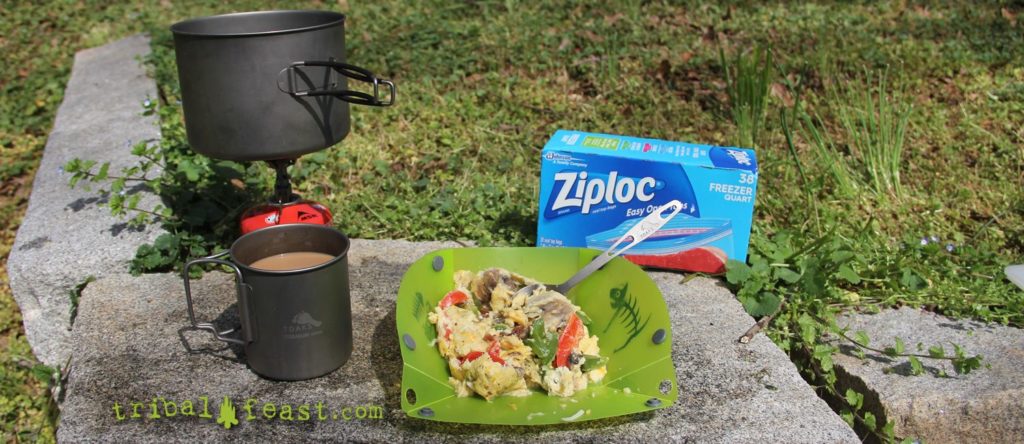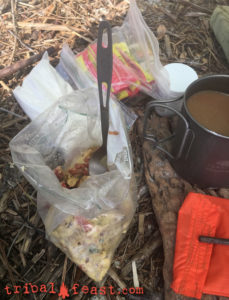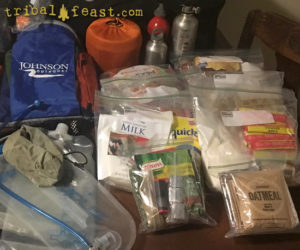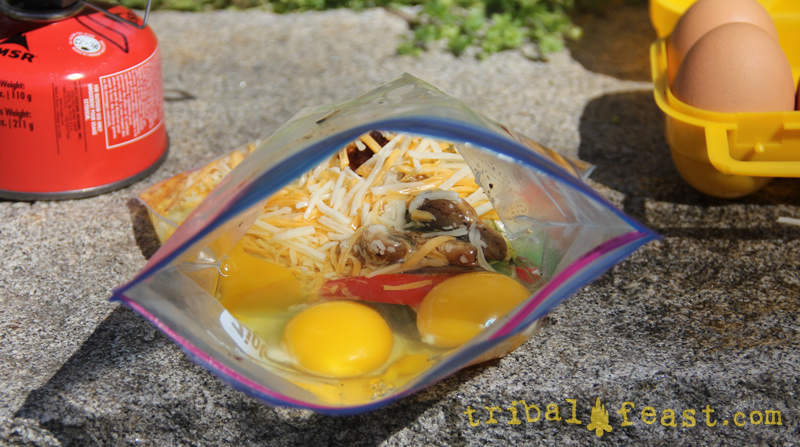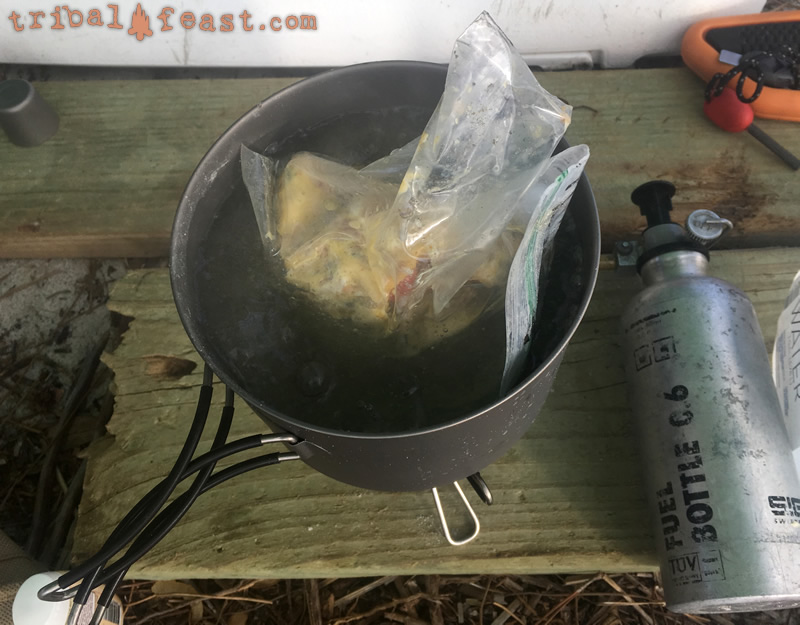Freezer bag meals are a fantastic approach to food prep for adventure picnicking and have been a long-time staple of thru-hiking, sea kayaking, multi-day camping trips, backcountry expeditions, and a myriad of other outdoor activities.
For an active outdoors person who is carrying all of his or her own gear and food stocks, having tasty meals that are compact, lightweight, and easy to prepare is extremely important. Food that that can be heated or cooked with a minimal amount of fuel is also a huge consideration when pack space is limited and the situation doesn’t allow for cooking over fires. Freezer bag meals cover all of these bases.
Another huge advantage of freezer bag meals is that they are not only prepared in a freezer bag, but can be eaten right out of the bag as well! This means no pots or dishes to clean and the used bag can be sealed up so that it doesn’t make a mess when stuffed back into your pack when hiking out.
Choose the Best Quality Freezer Bags
The one cardinal rule of freezer bag meal prep is to use the best quality freezer bag you can find. Cheaper, thinner bags cannot take the heat of boiling water and can also be weakened from the abuse of being crammed into the backpack of an active hiker.
Ziploc brand bags are our bag of choice, as they have consistently proven to be up to the challenges of freezer bag cooking. Bag failures can be messy and also leave you hungry when you are out on your adventure, so choose wisely, Grasshopper.
There are Two Types of Freezer Bag Meals
If you are new to freezer bag meals, it is important to understand that there are two distinctly different types of freezer bag meal preparation, and freezer bag meal recipes will also fall into these two categories. The first is using freezer bags to rehydrate and heat dried food, the second is to actually cook fresh ingredients in a freezer bag. Let’s take a closer look at each type.
Freezer Bag Rehydrating and Heating
The most common type of freezer bag meal entails putting together a selection of dried and/or fresh ingredients in a freezer bag and then pouring boiling water into the bag to both heat and reconstitute the dried ingredients. If you have ever had a store bought, dehydrated backpacker meal from a brand like Mountain House or Backpacker’s Pantry, this is basically the same concept, except you are in control of the ingredients.
Dehydrated freezer bag meals are ideal for situations where packing, weight, and nutrition are a concern. They are great for through hiking, extended camping and paddling trips, sea kayak camping, They are also ideal for extended trips where it is possible to filter water. Basically, a lot of food can be carried since there is no need to carry potable water.
Another huge advantage of freezer bag meals is that every meal on an upcoming trip can be prepacked and planned out, so you know long before you leave how much your food will weigh and how much space it will take up. DIY freezer bag meals can be mixed with a stock of store bought backpacker meals to offer variety and better nutrition.
For the adventure picnicker, this type of freezer bag meal is more for extreme day adventures where weight and space are at a premium, or extended camping trips and expedition travel. But if you are the type to go tearing off on one hour lunch break adventures from your workplace, this type of meal can be ideal, and you can package days or weeks of lunches far in advance of when they are eaten.
Sourcing Dehydrated Ingredients for Freezer Bag Meals
You may not have realized it, but many of the prepackaged processed side dishes you find in your local grocery store can actually be repackaged in a freezer bag and “cooked” with the method above. Some can even be rehydrated right in the pouch you buy them in! Good examples are the flavored noodle and rice dishes from brands like Knorr, Near East, and Uncle Ben’s. Be aware that many of these types of meals were meant to be cooked on the stove so they’ll take a long time to rehydrate – especially the pasta dishes. A “cozy” is a necessity for these meals and we’ll talk more about that below.
The above side dishes can also be used as a base for a more elaborate freezer bag meal, but more often dried rice, beans, couscous, or pasta is used as a base for DIY meals, then other dried ingredients are added. Once you start dabbling in freezer bag meals, you’ll find your home pantry filled with things like powdered eggs, instant potatoes, bacon bits, minute rice, Stove Top Stuffing, powdered soup mixes, powdered sauce packets, mac & cheese, and various types of Chinese noodles.
Creating your own freezer bag meal isn’t rocket science, just throw some dried ingredients into a freezer bag at home and then pour boiling into the bag and allowing the ingredients to rehydrate when you are at your alfresco dining destination. The most critical consideration is how much water to add for the various ingredients and experimentation with each dish you create is part of the process. However a great tip to cover up the mistake of adding too much water is to bring along a small amount of dried potatoes. These are great for soaking up excess water without changing the flavor of your meal too much.
Getting Cozy with Freezer Bag Meals
If you really get into making your own freezer bag meals, a food dehydrator and a vacuum sealer can take your freezer bag culinary exploits to the next level. For those starting out, however, one accessory that you will want to consider right away is the cozy.
A cozy is quite simply an insulated pouch that keeps your food warm while it is rehydrating. Our favorite for backpacking is this one from Big Sky, but there are many DIY tutorials across the web that detail making a cozy from materials you may have around the house. For the adventure picnicker, however, to whom weight is not so much of an issue, we recommend a different approach. A small insulated lunch cooler like the Igloo Bag It makes a great cozy, but can also serve as an ultralight, one meal cooler for fresh foods.
Freezer Bag Cooking
The second type of freezer bag meal entails putting a selection of ingredients (usually fresh) into a freezer bag, then boiling the bag to actually cook the food. Obviously, this method is only ideal for certain types of ingredients and you wouldn’t cook a steak this way, but for certain things like fish and eggs, it is a fantastic approach to creating a tasty meal in the backcountry.
For the adventure picnicker, for whom weight and space is not as critical as for a thru-hiker or expedition sea kayaker, this approach to freezer bag meal food preparation offers much more opportunity for culinary expression and for choosing healthier ingredients.
Boiling fresh foods in a freezer bag seals in flavors and juices and is great for experimenting with marinades and spice combinations. It also allows for very healthy cooking since oil, butter, and other fats that are necessary for pan frying and other types of cooking can be reduced significantly if not completely avoided. And like rehydrated freezer bag meals, there are not pots or pans to scrub and if you eat out of the bag, no plates to clean.
Freezer Bag Cooking Tips
We’re going to say it again: use only top quality freezer bags! Many cheaper freezer bags won’t survive being boiled in a small pot. There also can be some concern about toxicity when heating cheaper bags, especially those that contain BPA. Ziploc are BPA free.
Also, when boiling your freezer bag meal, make sure you use enough water to keep the bag from contacting the side of the pot for any extended period of time. While a good freezer bag can resist the temperature of boiling water, the metal of the pot will quickly melt a hole in the bag flooding it with water and potentially ruining your meal.
Freezer Bag Cooking Recipe Ideas
Steaming fresh veggies is easy in a freezer bag. Simply place the veggies and whatever spices you prefer along with a small amount of water in the freezer bag and boil until tender.
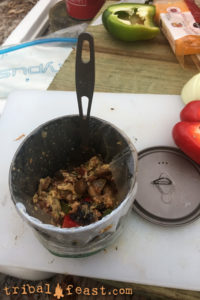
For fish, shellfish, and chicken, the outcome can be similar to cooking in parchment, where the meat is . basically poached in its own juices. The meat is heated evenly without scorching and overcooking is nearly impossible. Get creative with veggies and sauces and make a one bag, full course meal.
One of the easiest and most delicious freezer bag meals for those just getting started is an omelet. Eggs lend themselves to freezer bag cooking and once you’ve cooked an omelet this way while out on an adventure, you’ll be tempted to use the same technique for omelet cooking at home.
The simple omelet recipe below will help you get started, but you will soon find out that freezer bag cooking is very forgiving and you will find yourself experimenting with new ingredients and recipes right away. Bon appetit!
Simple Freezer Bag Omelet
Ingredients:
- Three eggs
- ⅓ cup of chopped onion
- ⅓ cup of chopped mushrooms
- ⅓ cup of chopped green pepper
- ⅓ cup of cheddar cheese
Directions:
- Put vegetables and cheese into a quart-sized freezer bag.
- Crack the eggs into the bag.
- Seal the bag, pushing some of the air out before completely closed.
- Knead to mix ingredients.
- Boil in water until eggs are completely cooked.
- Enjoy!

